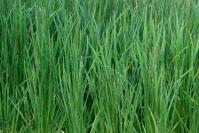Oryza sativa
- Overview
- Images
- Identify
- Biology
- Taxonomy
- Occurrence
- Specimen

Description
Stem (culm) is erect or ascending from a geniculate base, cylindrical, smooth, glabrous. Leaf sheath are glabrous, slightly inflated below, upper sheaths tight, green or sometimes tinged with brown or purple. Ligule is 1-4 cm long, triangular, acute, entire or split, membranous. Auricles are often present, falcate, 1–5 mm long, hairy. Blade is linear, tapering to an acute point, 25-65 cm × 0.5-2 cm, bright green to glaucous, glabrous or finely pubescent, smooth on the lower surface, slightly rough on the upper surface, margins rough, midrib usually distinct. Inflorescence is a terminal panicle up to 50 cm long, erect, curved or drooping, with 50–500 spikelets; branches solitary or clustered, nearly erect to spreading. Spikelet is solitary, asymmetrically oblong to elliptical-oblong, 7-11 mm × 2-3.5 mm, with pedicel up to 4 mm long, 3-flowered but 2 lowest florets reduced to sterile lemmas 1.5-4 mm long. Glumes are small. Lemma of the fertile floret is 6-10 mm long, boat-shaped, papillose, covered by small spines, sometimes awned. Palea is about as long as lemma. Stamens are 6. Ovary is superior, with 2 featherlike stigmas. Fruit is a caryopsis (grain), ovoid, ellipsoid or cylindrical, 5-7 mmlong, often whitish yellow or brown to brownish grey.
The map represents observations of this taxon, but it may not be used as a distribution map.




- Total squares
- riisi (Finnish)